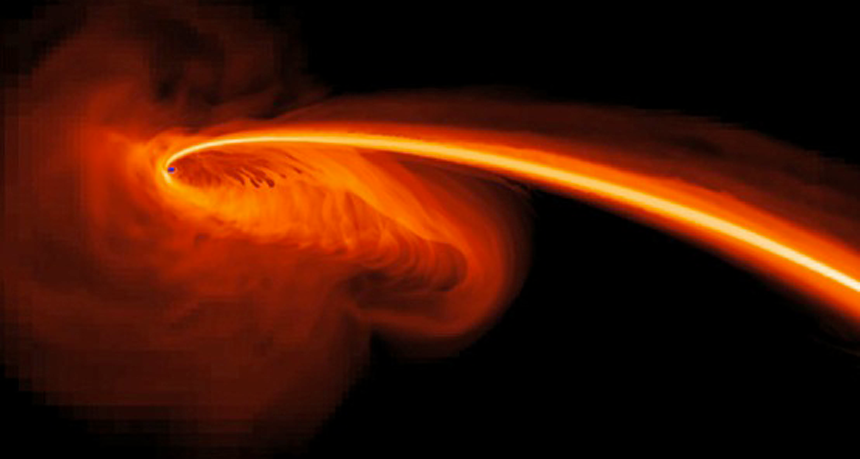Black hole’s big gulp
Astronomers say a bright flare in space shows where a black hole tore apart a star

This computer-simulated image shows gas from a tidally shredded star falling into a black hole.
NASA, S. GEZARI/JOHNS HOPKINS UNIVERSITY AND A. REST/SPACE TELESCOPE SCIENCE INSTITUTE
In a distant galaxy, there’s a black hole with a mighty appetite — and one less star shining in space.
In 2010, two telescopes picked up a bright flare coming from a usually dark spot almost 3 billion light- years away. (That means the light takes almost 3 billion years to get from there to here.) Over the next few months, the brightness dimmed. The light show was caused by a star being shredded by a black hole at the center of a distant galaxy, astronomers now believe.
The black hole is huge — about the same size as the one in the middle of the Milky Way, our home galaxy. Astronomers estimate that it has about as much mass — or stuff — as 3 million sun-sized stars smooshed together.
Anything with that much mass exerts a powerful gravitational pull on everything around it. The force of gravity brings objects together, and the more mass something has, the more gravity it exerts. Gravity is the force that keeps things on Earth’s surface from floating off into space.
But near a black hole, gravity becomes a menace, especially to a star zipping by. Nothing can escape the tremendous gravity of a black hole, not even light, the fastest-moving thing in the universe.
Astronomers suspect the recently shredded star had been moving along an elliptical orbit around the black hole. (An elliptical orbit has the shape of a rubber band whose two ends are being pulled slightly in opposing directions.) During one pass, the star got too close, and the black hole’s gravity tore the star apart. Scientists suspect the star had come close in a previous pass, but that time it lost only its outermost layers. On the second pass, the black hole devoured the star’s core.
The bright glow appeared as some of the star turned to tatters and fell into the black hole and the rest of the stellar stuff shot off into space. Over time, that star material fell back into the black hole.
Two telescopes spotted the flare in June 2010: the Pan-STARRS telescope, which sits on top of a volcano in Hawaii, and NASA’s Galaxy Evolution Explorer, which is a space telescope. The star’s light became brightest a month after it was discovered and slowly faded over the next year.
Astronomers who were watching thought the glow was either a new kind of supernova — a star explosion — or a black hole devouring a nearby star. After analyzing the data with computer programs, the scientists determined that a black hole was to blame. It’s a lucky discovery, since these kinds of black hole “meals” probably happen only once every 10,000 years in any given galaxy.
Power Words
black hole A region of space having a gravitational field so intense that no matter or radiation can escape.
gravity The force that attracts any body with mass, or bulk, toward any other body with mass. The more mass there is, the more gravity there is.
mass The quantity of matter that a body contains.
light-year The distance light travels in a year, nearly 6 trillion miles.
elliptical Having the shape of an ellipse, which is an oval shape.







